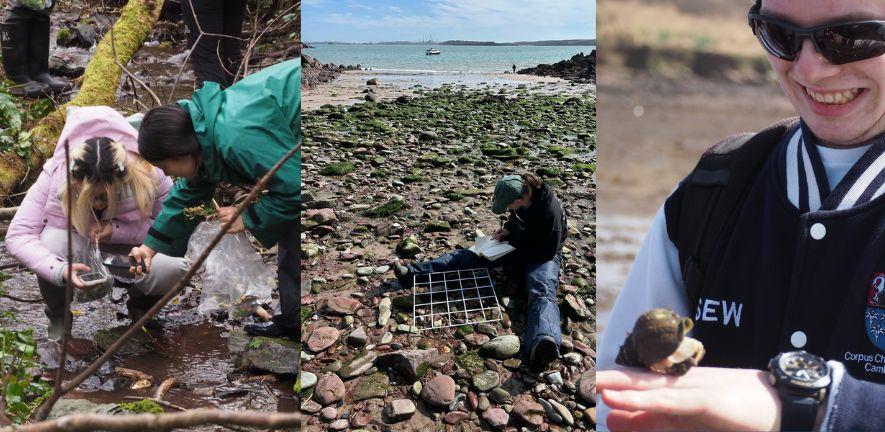
Submitted by Abigail Youngman on Wed, 23/04/2025 - 15:28
Field courses are a key part of our undergraduate teaching: they help students put the material from their lectures in context, develop a spirit of curiosity, and engage with each other and their teachers in a more informal environment.
Dr Hamish Symington, Postdoctoral Researcher in the Glover Lab, Department of Plant Sciences, writes about a recent trip to Dale in Pembrokeshire.
At the start of the Easter break 2025, two groups of 30 students studying first-year Evolution and Behaviour headed west for a week’s field trip led by the Departments of Zoology and Plant Sciences. Staying at Field Studies Council centres in Dale (Pembrokeshire) and Slapton (Devon), the students were able to put the organisms they’d met on their lecture course into context in the real world.
Discoveries
The students first explored a local woodland, getting to grips with plant anatomy and identification. They unravelled developing ferns, found liverworts and mosses by the banks of a small stream, and examined the reproductive structures of flowers such as primrose and red campion. Back in the ‘lab’ (a converted classroom), a van-load of kit from Cambridge enabled microscopic study and dissection, giving a practical understanding of concepts which many students had previously only been taught in theory.
The following day the team headed to Marloes Sands, a Site of Special Scientific Interest. There they found fossils of creatures which had been introduced in the ‘evolution of animals’ section of their lecture course: crinoids, corals, brachiopods, gastropods and, much to everyone’s delight, some trilobites. There was also plenty of opportunity for birdwatching and an introduction to plant life on a rocky, windswept headland.
Heading to the intertidal zone on the rocky shores an exceptionally low tide uncovered many unusual organisms, including nudibranchs (sea slugs), cushion stars, blue-rayed limpets, squat lobsters and more.
On the final day of teaching, the team visited the Gann mudflat, where another very low tide led to the discovery of a wealth of species, including more nudibranchs, whelks, a dogfish and its eggs, starfish, pipefish, terebellid worms, scallops and a sea hare. Again, our lab setup allowed students to carefully examine the anatomy and behaviour of many invertebrate organisms before we released them back where they had been found.
Project work
One important aspect of the field courses is that they allow students to try project work: formulating a question, measuring data to try to answer that question, then presenting their findings to the group. All the while, their teachers were on hand to help students understand techniques, take appropriate measurements and run statistical analyses.
Projects ranged from the behaviour of toothed periwinkles when placed in groups on rocks, coverage of seaweed over different parts of the beach, how plankton abundances varied with the tide, measurement of microplastics and trial of a new, simpler method for detecting them, and the prevalence of lichens on different surfaces and in different environments (which won the ‘best project’ award).
Feedback
The group thoroughly enjoyed their fieldwork, describing it as an ‘amazing trip’ and ‘extremely fun’, with one commenting 'I have really really loved the course, and I didn’t want it to end. I learnt so much doing what I love … The [teachers] were just epic!’
Images:
Stream: On the first day, the students headed into a nearby woodland to explore the diversity of plant life. Students took samples to explore under the microscope, and uploaded observations to iNaturalist.
Person on beach: One team measured seaweed diversity across transects of the beach, exploring the relationship of substrate, species and distance from high water mark. Here, Jenna is using a quadrat to help her quantify species abundance.
Grimace: On the mud flats, we found several large whelks, which will happily wander across the back of a hand.
Photo of organisms: top row: sea lemon, squat lobster, sea hare; bottom row: rosy feather star, blue-rayed limpet, spined starfish.
Rockpooling: The trip is carefully planned around tide times, making sure that the students are able to go rockpooling before lunch on one of the days. This year, there was an unusually low tide, meaning the students could find nudibranchs ('sea slugs’), cushion stars, brittle stars, blue-rayed limpets, sea cucumbers, squat lobsters and more.


